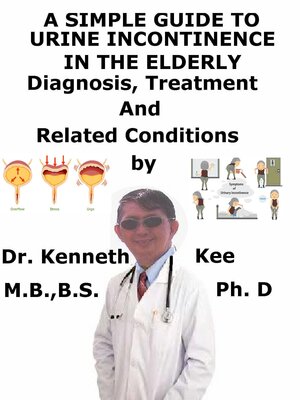A Simple Guide to Urine Incontinence in the Elderly, Diagnosis, Treatment and Related Conditions
ebook
By Kenneth Kee

Sign up to save your library
With an OverDrive account, you can save your favorite libraries for at-a-glance information about availability. Find out more about OverDrive accounts.
Find this title in Libby, the library reading app by OverDrive.



Search for a digital library with this title
Title found at these libraries:
| Library Name | Distance |
|---|---|
| Loading... |
This book describes Urine Incontinence in the Elderly, Diagnosis and Treatment and Related Diseases which is seen in some of my patients in my Family Clinic.
Urine incontinence (UI) is the loss of bladder control leading to the involuntary leakage of urine, and significantly impacting quality of life.
It is common in older adults (older than 65 years) but should not be dismissed as an inevitable part of aging.
Urinary incontinence in older adults is not just a minor inconvenience.
It significantly impacts physical health, mental well being, and quality of life.
Treating UI promptly is important to prevent complications and improve overall outcomes.
1. Prevent Physical Complications
a. Skin Breakdown and Infections: Constant moisture from urine leakage increases the risk of dermatitis, pressure ulcers, and urinary tract infections (UTIs).
b. Fall Risk: Rushing to the bathroom, especially at night, raises the likelihood of falls and fractures (e.g., hip fractures).
c. Renal Damage: Chronic urinary retention (overflow incontinence) can lead to kidney dysfunction.
2. Improve Mental Health and Dignity
a. Depression and Anxiety: Embarrassment and social stigma often lead to isolation, depression, and reduced self esteem.
b. Loss of Independence: Fear of accidents may cause older adults to avoid outings, hobbies, or social interactions.
3. Enhance Quality of Life
a. Restore Confidence: Effective treatment allows individuals to engage in daily activities without fear of leakage.
b. Better Sleep: Reducing night time urination (nocturia) improves sleep quality and energy levels.
4. Reduce Caregiver Burden
a. Hygiene Management: Untreated UI increases caregiver workload (e.g., frequent clothing/bedding changes).
b. Emotional Stress: Caregivers may experience frustration or burnout when managing recurrent accidents.
5. Treat Underlying Medical Conditions
UI can signal treatable issues, such as:
a. Urnary Tract Infections (UTIs): Common in older adults and often reversible.
b. Prostate Enlargement (BPH): A leading cause of overflow incontinence in men.
c. Neurological Disorders: Stroke, Parkinson's, or diabetic neuropathy may require targeted care.
6. Avoid Unnecessary Institutionalization
Severe, untreated UI is a key reason families consider nursing home placement.
Managing symptoms helps older adults remain independent at home longer.
7. Cost Effect Care
Early intervention reduces long term costs associated with:
a. Hospitalizations for UTIs or falls.
b Incontinence supplies (pads, catheters).
c. Skin ulcer treatments.
Prognosis varies by type, severity, and adherence to treatment:
1. Stress Incontinence:
Prognosis: Excellent with early intervention.
Outcomes:
70–80% improvement with consistent pelvic floor exercises.
>90% success rate with surgical sling procedures.
2. Urge Incontinence (Overactive Bladder):
Prognosis: Manageable but may require longterm therapy.
Outcomes:
50–75% symptom reduction with medications (e.g., anticholinergics, mirabegron).
Botox injections provide relief for 6–12 months in refractory cases.
3. Overflow Incontinence:
Prognosis: Depends on addressing the cause (e.g., prostate enlargement, neuropathy).
Outcomes:
Prostate surgery (e.g., TURP) resolves symptoms in 85% of men.
Intermittent catheterization effectively manages chronic retention.
4. Functional Incontinence:
Prognosis: Tied to improving mobility/cognition.
Outcomes:
Caregiver-assisted toileting and home...







